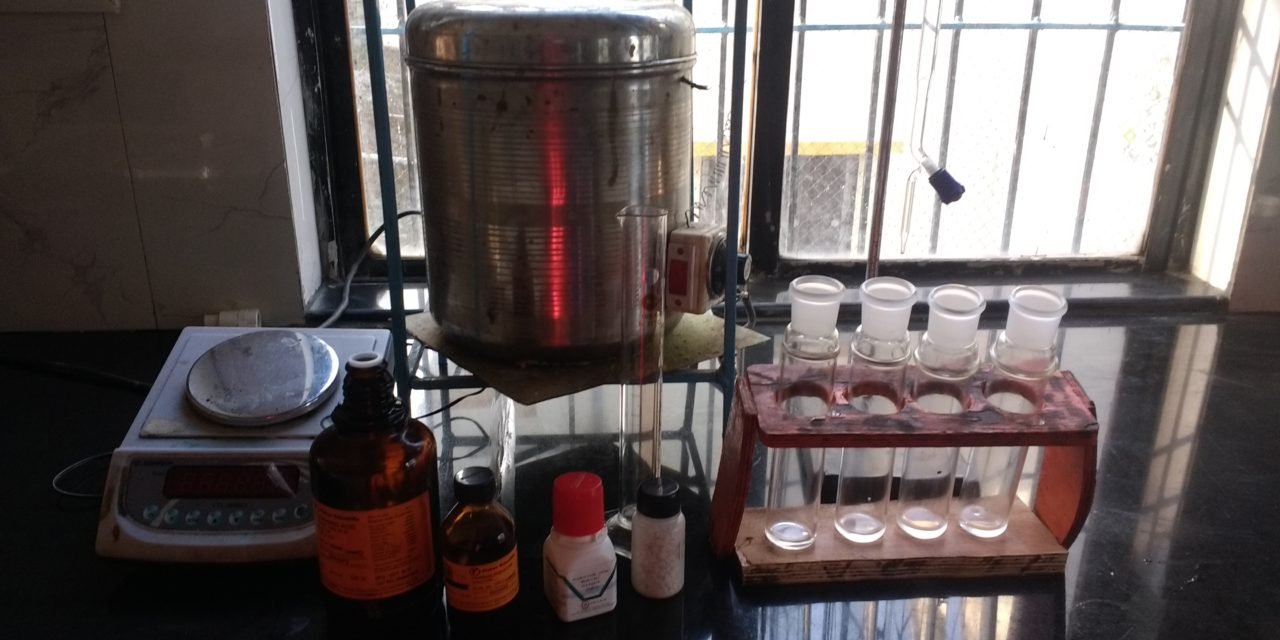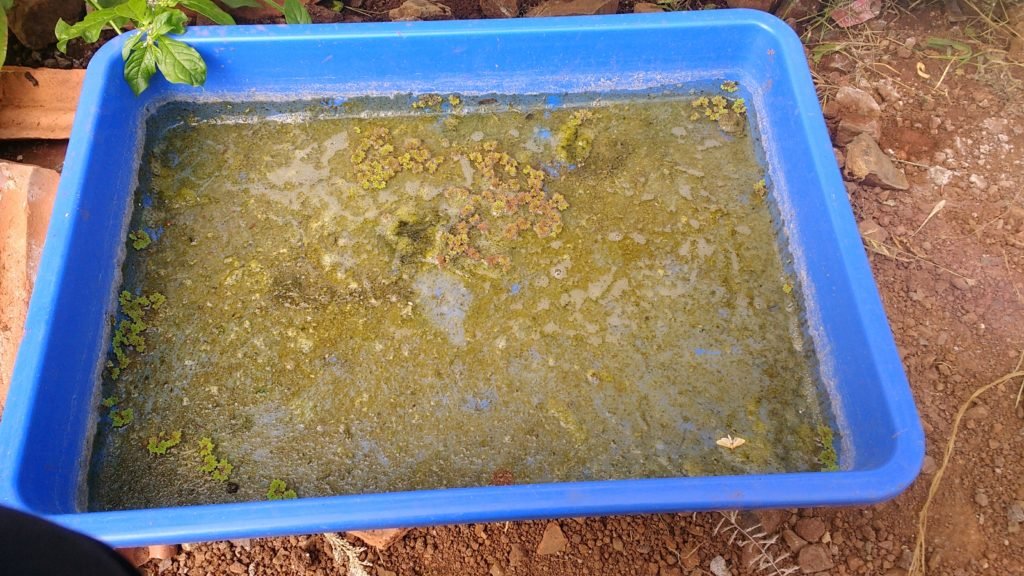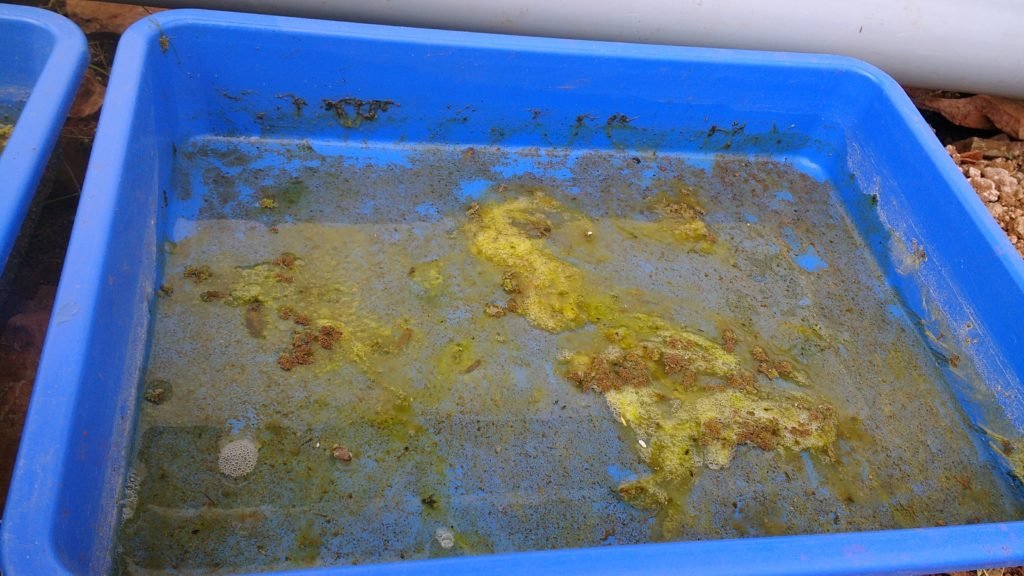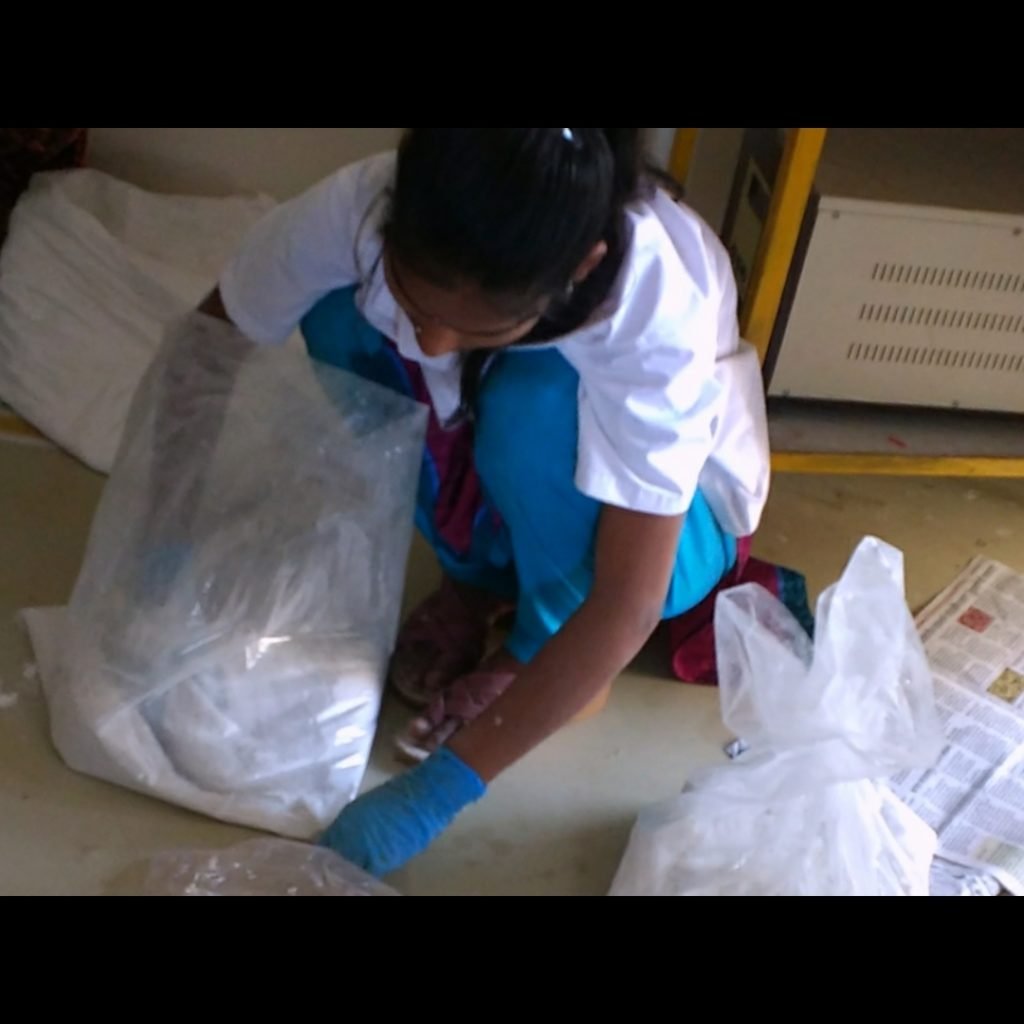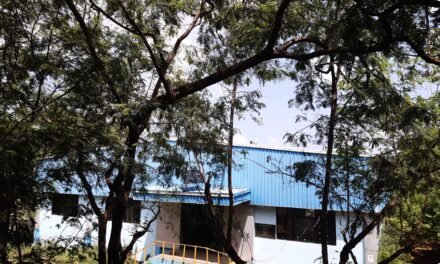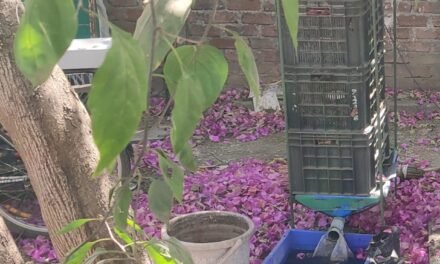COD test on gry water
Material required : COD operators, weighing Balance, FAS solution, K2Cr2O7 sollution, Hydro sulfuric acid, Fisher reagent, HgSo4 powder
Procedure
- I took outlet water sample in behind kitchen gry water system
- taken 0.4gm HgSo4 in cod tube
- Add 20ml (sample KHP) +20ml distelled water mix well
- Add stone(cruston beads) 1 or 2
- Add 10ml (0.25 N) k2Cr2O7 sol dicromal solution
- Add 30ml hidro sulfuric acid slowil along with swirlin
- If term green add more K2Cro2 7
- Mix And attach condencer
- Reflux for 2hr cool Wash condenser with distelled water 150 digreeshelshious temperature
- Add about 150ml distilled water
- Titrate it with 0.1N. FAS
- Blue green turn to Redish brown

| Date | inlet of home grey water system | out let | inlet of kitchen grey water system | out let | inlet of boys hostel grey water system | out let | girls hostel grey water system | ||
| 18/09/2019 | 0 | 0 | 0 | 132.6 | 581.4 | 10.2 | 0 | 0 | |
| 24/09/2019 | 0 | 51 | 0 | 132.6 | 0 | 102 | 0 | 0 | |
| 1/10/2019 | 275.4 | 0 | 642.6 | 0 | 632.4 | 0 | 0 | 0 | |
| 9/10/2019 | 387.6 | 0 | 0 | 295.8 | 0 | 193.8 | 0 | 0 | |
| 15/10/2019 | Jan-00 | 204 | 0 | 428.4 | 0 | 102 | 0 | 0 | |
| 23/10/2019 | 0 | 122 | 0 | 102 | 0 | 112.2 | 0 | 0 | |
| 6/11/2019 | 0 | 0 | 1183.2 | 673.2 | 0 | 0 | 0 | 0 | |
| 13/11/2019 | 0 | 0 | 758.5 | 197.5 | 0 | 0 | 0 | 0 | |
| 17/11/2019 | 408 | 173.4 | 816 | 214.2 | 0 | 0 | 0 | 0 | |
| 28/11/2019 | 102 | 81.6 | 1224 | 1020 | 0 | 91.8 | 1685 | 0 | |
| 3/12/2019 | 0 | 0 | 408 | 633 | 0 | 0 | 0 | 0 | |
| 17/12/2019 | 204 | 91.8 | 1785 | 40.8 | 102 | 0 | 0 | 0 | |
| 24/12/2019 | 142.8 | 122.4 | 2196 | 204 | 571.2 | 3360 | |||
| 1/1/2020 | 153 | 20.4 | 1071 | 112.2 | 660 | 163.2 | 0 | 0 | |
| 7/1/2020 | 132.6 | 91.8 | 816 | 459 | 561 | 122.2 | 0 | 0 | |
| 13/1/2020 | 200 | 40 | 765 | 132.2 | 1400 | 102.2 | |||
| 1/21/2020 | 102 | 61.2 | 357 | 30.6 | 71.4 | 10.2 | |||
| 27/1/020 | 240 | 0 | 800 | 95 | 400 | 160 | |||
| 0 | |||||||||
| 3/2/2020 | 160 | 0 | 1000 | 400 | 406 | 132.6 | 1071 | ||
| 0 | |||||||||
| 11/2/2020 | 142 | 0 | 561 | 132 | 660 | 91.8 | 969 | ||
| 17/2/2020 | 132 | 0 | 510 | 71.9 | 538 | 210 | 669 | ||
| 26/2/2020 | 142 | 0 | 674 | 108 | 490 | 153 | 783 | ||
| 3/3/2020 | 202 | 0 | 815 | 217 | 321 | 130 | 690 | ||
| 15/4/2020 | 153 | 112.2 | 489.6 | 91.8 | 61.2 | 408 | |||
| 20/4/2020 | 306 | 142 | 501 | 115 | 225 | 110 | 0 | ||
| 27/4/2020 | 51 | 0 | 355.2 | 102 | 159 | 109 | 357 | ||
| 14/5/2020 | 153 | 95.8 | 349 | 124 | 102 | 183.6 | |||
| 23/5/2020 | 103 | 82.6 | 255 | 204 | 112 | 387 | |||
| 28/5/2020 | 204 | 71.4 | 612 | 102 | 357 | 765 |




Assignment 2:Azolla Bed(19/10/11)
Trails on Azolla plant
procedure:
- we prepare three beds to fill with water
- And add 5gm of Azolla plant of each bed
- And teke the PH, EC, TDSand SALT readings as follows
| BED No. | PH | EC | TDS | SALT |
| BED 1 | 9.06 | 27.2 | 19.2 | 10.2 |
| BED 2 | 8.88 | 140.2 | 10.6 | 67.9 |
| BED 3 | 8.84 | 24.6 | 17.1 | 10.6 |
4. After add 1 drop HCL on each bed mix it properly
After adding HCL
| BED No. | PH | EC | TDS | SALT |
| BED 1 | 6.5 | 28.9 | 20.6 | 10.6 |
| BED 2 | 6.5 | 149.7 | 10.7 | 68.2 |
| BED 3 | 6.5 | 26.4 | 10.3 | 11.2 |
After i kept that small treys on the poly house after 5 days i observed the treys that azolla whatever i put in that treys it it will in death phase
Assignment No. 3 Soil Testing(15/10/11)
SOIL TESTING
I performed soil testing of two samples brought by the farmer. soil testing was done by using the ‘Nagarjuna kit’. Following is the result:
| Sr.No. | Parameter | Sample 1 | Sample 2 |
| 1 | PH | 8.5 | 8.3 |
| 2 | EC | 0.33 ms/cm | 0.34 ms/cm |
| 3 | OC | 2.66 kg/ha | 50.94 kg/ha |
| 4 | p | 0.47 % | 0.35% |
| 5 | Mn | 10.8 mg/kg | 22.25 mg/kg |
| 6 | Fe | 11.7 mg/kg | 4.5 mg/kg |
| 7 | Cu | 8.98 mg/kg | – |
| 8 | k | 304.4 mg/kg | – |
| 9 | S | 4.00 mg/kg | – |
| 10 | Zn | 1.11 mg/kg | – |
| 11 | B | 0.09 mg/kg | – |
Trial – 2 (19/11/19 to 20/11/19)
soil testing of two samples brought by one village farmer soil was done by using Nagarjuna kit
| Sr. No. | Parameter | sample-1 | Sample-2 |
| 1. | PH | 7.17 | 7.35 |
| 2 | EC | 0.49 | 0.20 |
| 3 | OC | 1.99 % | 1.90 % |
| 4 | N | 613.5 kg/ha | 591.3 kg/ha |
| 5 | P | 53.62 kg/ha | 67.92 kg/ha |
| 6 | K | 158.6 kg/ha | 20.63 kg/ha |
| 7 | S | 32.o mg/kg | 45.0 kg/ha |
| 8 | Z | 2.96 mg/kg | 3.51 mg/kg |
| 9 | Fe | 2.24 mg/kg | 2.46 mg/kg |
| 10 | Cu | 1.59 mg/kg | 13.2 mg/kg |
| 11 | Mn | 1.80 mg/kg | 22.0 mg/kg |
| 12 | B | 0.92 mg/kg | 8.83 mg/kg |
In this month 5/3/2020 to 25/3/2020 i completed soil testing on 100 soil sample was done by using narjuna kit on 6 parameter
ex: Babhurao maruthi sandbhare
| sr. no | parameter | reading |
| 1 | PH | 7.5 |
| 2 | EC | 0.81 |
| 3 | OC | 0.02% |
| 4 | N | 124.2 |
| 5 | P | 18.7 |
| 6 | K | 156.8 |
Cultivation of Trichoderma
Introduction
Trichoderma are free living fungi that are common in soil and root ecosystem they are highly interactive in soil and foliar environments they produce or release a variety of compounds that induce localized or systemic resistance responses in plants. Trichoderma have long been recognized as biological agents, for the control of plant diseases and for their ability to increase root growth and development, crop productivity, resistance to abiotic stresses and uptake of nutrients.the field application of trichoderma requires mass multiplication which can be done using solid as well as liquid state fermentation.
Understanding part
multiplication of trichoderma for commercial formulation. however, solid state fermentation is to low initial investment as well as availability of cheap labour and space solid state fermentation technology uses food grains including sorghum and Bajra for commercial mass multiplication of trichoderma at any industrial scale.grains are useful for solid state fermentation only. On other hand tamarind seeds are available as a byproduct and fetches negligible price they can be produced when available and can be stored for longer time and it is useful for both solid as well as liquid formulations depending up on the available facility with the user
USES Of Trichoderma
- Trichoderma is a highly efficient producer
- Biocontrol agent
- Plant growth promotion
Preparing Trichoderma media
Material Required: Crushed tamarind seeds, conical flask, talc powder,glows,Worm water, Cotton plug,
Why tamarind seeds chooses
Tamarind seeds content mostly starch and polysaccharides. The chemical constituents of tamarind seeds include carbohydrate(73.68) includes starch xylose, glucose and fructose proteins and moisture this all are supports growth of fungus. But in addition xylanase and glucanases induces resistance against diseases in plants the seed coat contents polyphenols which has antimicrobial properties. In this technology, I found that these seeds supports very good growth of fungus like Trichoderma
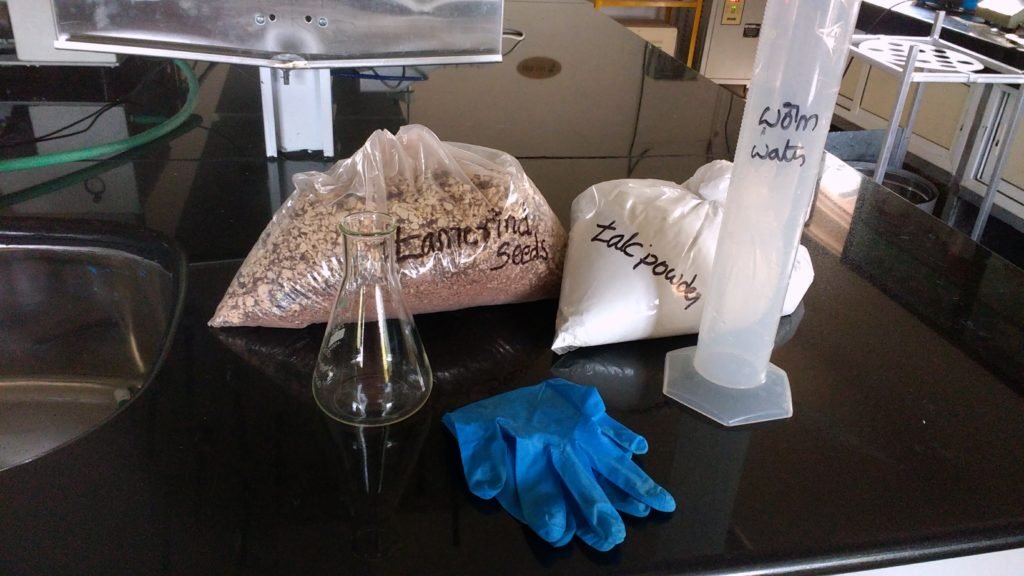
Procedure:
- I took 50gm crushed tamarind seed for 500ml flask and 25gm for 250ml flask
- kept into that flasks and add normal water in it
- And cover flask mouth with cotton plug
- kept it a whole night for socking
- After 24 h remove water from that seeds
- And autoclaved the meadia at 15 psi
- And allowed to cooling the meadia
- And inocullate it with the help of 1gm of trichoderma powder
- After inoculation kept it 6 to 10 days for growing trichoderma
Below pitcher shows before inoculation

After 10 days
Observation part
After 10 days observation I found trichoderma viride what ever we looking that green color is called trichoderma viride

9. I kept it out side for drying
10.It takes 2 to 4 days for drying
11.After drying crushed it with the help of mixer
12.After mix that trichoderma powder in talcum powder
1 gm trichoderma powder for 100 gm talcum powder
Final product

Plating of Trichoderma viride by using serial dilution and spread plate techniq(07/12/2019)
- for this i want 10 sterilized test tubes
- And 9 ml sterilized distilled water transfer into all 10 test tubes with the help of measuring cylinder
- 1 gm of trichoderma powder
- And add 9 ml sterilized distilled water mix it well
- And 0.2 ml suspension with the help of micro pipette
- And transfer into petri plate
- And spread it all over plate with the help of spreader
- And labelled name and date in that plate
- And fix it paraffin film
- And kept it incubator at 30 to 35 degree celcius
- Observe growth every 24 hrs
Observation part
In this plates I observed another unknown growth but i want pure Trichoderma viride thats why i done streakig of thrichoderma on PDA plate

Streaking Of thrichoderma on PDA plates(07/12/2019)
Procedure :
- First made the sterilized PDA plates
- Andwe took before trichoderma plate
- And sterilized the laminarflor
- And taken loop of trichoderma with the help of sterilized streaking loop
- And we took PDA plate and streaking the plate by using 4 quadrant method
- And kept it incubator at 30 to 35 degree celcius
- And observe growth every 24 hrs
After 2 days
Observation part

| Batch no. | Date | Tamarind seed powder | Talk powder |
| 1 | 2/11/2019 | 168 gm | 3.8 kg |
| 2 | 7/11/2019 | 170 gm | – |
| 3 | 12/11/2019 | 194 gm | – |
| 4 | 22/11/2020 | 152.90 gm | – |
| 5 | 5/12/2019 | 276 gm | – |
Terrace Farming
(04/05/2020)
Project background
To develop a terrace farming model which can be replicate in urban housing buildings with objective of growing vegetables using composting of kitchen waste
Need
1. availability of fresh vegetables
2. chemicals free vegetables requirement
3. Self sufficiency for vegetables.
Leafy vegetables plot making
Methodology
- compost and soil mixture preparation
A) compost
- Raw compost taken.
- Crushing and grading done for the compost
- and i took 20% compost for trichoderma treatment
- 5%trichoderma mix with 20% compost
B) Soil: (
For this i took poly house soil and seaved it
compost :soil
for this i used 1:4 prepotion of soil and compost and mixed well and add water for it
Breaks :60 breaks
Other task:
1.add 2lit varmivash for plants growth
2. Spray the neam oil(5ml in 1lit water) for leaf miner flies
3. spreyed of soda on aeroponics plats for controlling the leaf miner
Preparation of plots for leafy vegetables:
First plot
Composting plot
- 5feet breadth and 10feet length was used by one plot
- Total 15 breaks was used for one plot
- In that first added to dry matter next added compost layer
- And add some water for moisture
- In first plot we want to grow up the spinach
Description
- Spinach is a leafy green flowering plant Its leaves are a common edible vegetable consumed either fresh, or after storage using preservation techniques by canning, freezing, or dehydration.
Second plot
Composting plot
- For this plot we used as fist plot steps
- In this plot we want to formed the dill/shepu plant
Description
- Dill is an annual herb in the celery family Apiaceae. It is the only species in the genus Anethum. Dill is grown widely in Eurasia where its leaves and seeds are used as a herb or spice for flavouring food.
Face mask
project background
material required:
- sewing machine
- pins to hold the fabric
- cotton fabric
- scissor
- measurement tap
step:1 preparation of fabric material
- we took cotton fabric and washed properly and dried it
- cut the fabric with the help of proper measurements
- Measurements: 9 inch length and 8 inch breadth for this we get the help of video suggested by Dr. Arun dixith
step:2 preparation of mask
- Sew a straight line across the mask and bottom edges of the fabric
- Sew the over their ends
- Make a pleat and hold it with the help of pins
- sew the both sides and remove the pins
- And fold the edges of the fabric(0.5 inch) for “Not” and sew it
step:3 preparation of “Not”
- For this we want 30 cm length and 1.5 inch breadth
- And sew it very properly that was easy to move the mask
Total fabric :
Orange color fabric : 30 masks
Red color fabric : 20
Wasted masks:
Orange color fabric : 0
Red color fabric : 35 masks

